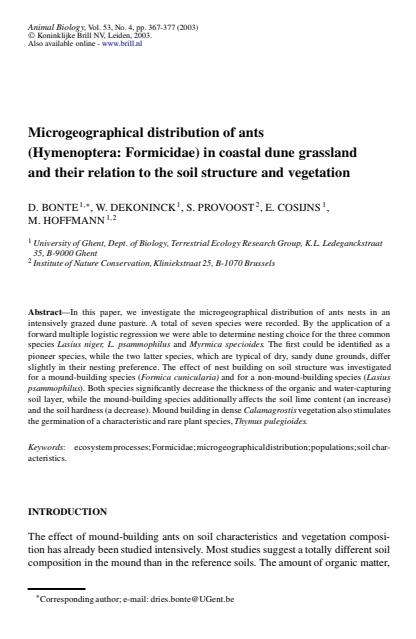Microgeographical distribution of ants (Hymenoptera: Formicidae) in coastal dune grassland and their relation to the soil structure and vegetation
Details
| Aantal pagina's | 11 |
|---|---|
| Volume | 53 |
| Tijdschrift nummer | 4 |
| Pagina's (van-tot) | 367-377 |
| Type | A1: Web of Science-artikel |
| Categorie | Onderzoek |
| Tijdschrift | Animal Biology |
| Issns | 1570-7555|1570-7563 |
| Uitgeverij | Brill Academic Publishers |
| Taal | Engels |
Bibtex
@misc{2ef3e6c1-f518-4afa-bed6-b8f52950d81c,
title = "Microgeographical distribution of ants (Hymenoptera: Formicidae) in coastal dune grassland and their relation to the soil structure and vegetation",
abstract = "In this paper, we investigate the microgeographical distribution of ants nests in an intensively grazed dune pasture. A total of seven species were recorded. By the application of a forward multiple logistic regression we were able to determine nesting choice for the three common species Lasius niger, L. psammophilus and Myrmica specioides. The first could be identified as a pioneer species, while the two latter species, which are typical of dry, sandy dune grounds, differ slightly in their nesting preference. The effect of nest building on soil structure was investigated for a mound-building species (Formica cunicularia) and for a non-mound-building species (Lasius psammophilus). Both species significantly decrease the thickness of the organic and water-capturing soil layer, while the mound-building species additionally affects the soil lime content (an increase) and the soil hardness (a decrease). Mound building in dense Calamagrostis vegetation also stimulates the germination of a characteristic and rare plant species, Thymus pulegioides.",
author = "D Bonte and D Bonte and W Dekoninck and W Dekoninck and Sam Provoost and Sam Provoost and Eric Cosyns and Eric Cosyns and Maurice Hoffmann",
year = "2003",
month = jan,
day = "01",
doi = "https://doi.org/10.1163/157075603322556274",
language = "Nederlands",
publisher = "Brill Academic Publishers",
address = "België,
type = "Other"
}
Auteurs
D BonteD Bonte
W Dekoninck
W Dekoninck
Sam Provoost
Sam Provoost
Eric Cosyns
Eric Cosyns
Maurice Hoffmann

